Revealed: secondary ITT target missed by half
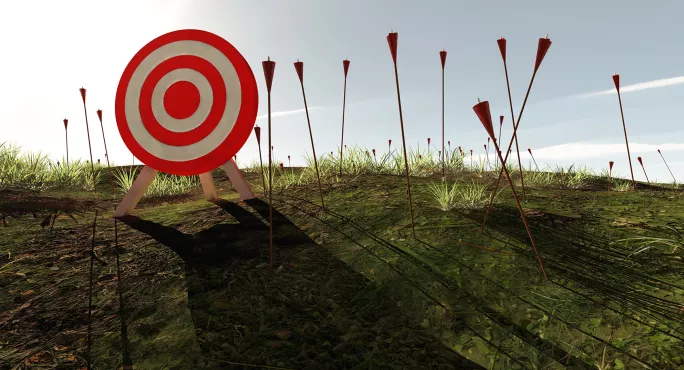
The government has missed its target for recruitment of secondary teacher trainees by 50 per cent - an even greater shortfall than last year, new Department for Education information reveals.
The data - which shows that just 13,102 trainees were recruited on to courses this year out of the 26,360 the government said were needed - was once again described as “catastrophic” and “even worse than last year” by heads’ leaders.
While the number of secondary trainee teachers entering training this year has risen by around 8.8 per cent, a huge increase in the government-set target means that the shortfall has widened.
- Exclusive: DfE workforce strategy delayed amid ‘uncertainty’
- Workload: The experts tasked with cutting five hours from teachers’ working week
- Teacher training: Secondary ITT recruitment “to fall short of target” again
Just over 12,000 secondary teacher trainees were recruited last year - 57 per cent of the numbers needed - but the target has been missed by an even wider margin this year owing to an increase in the number of teachers the government forecast would be necessary to run schools effectively.
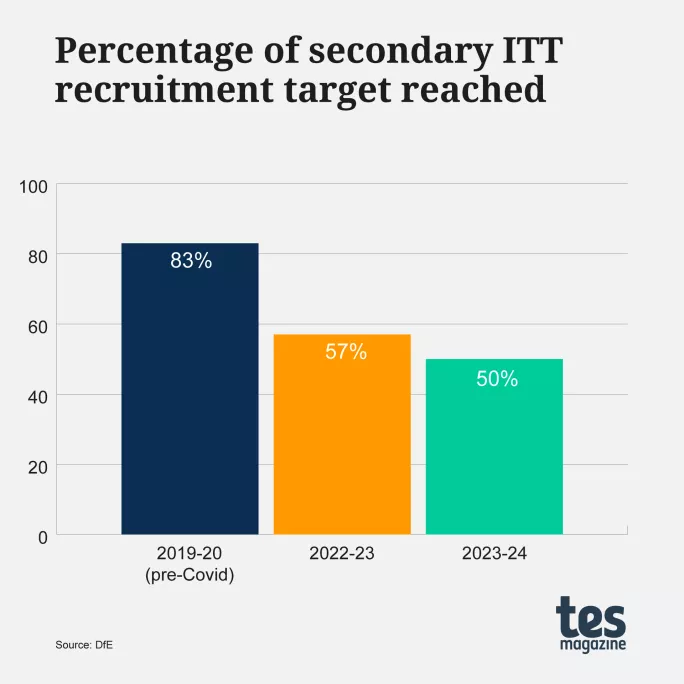
Stem and EBacc targets missed
The DfE teacher trainee targets were missed for 15 out of 18 subjects for the 2023-24 intake, the data shows, with Classics, history and PE trainee targets the only ones exceeded.
Just 49 per cent of the DfE’s recruitment target was achieved in science, technology, engineering and maths (Stem) this year, with only 4,504 trainees starting on courses instead of the 9,195 the DfE set as its target.
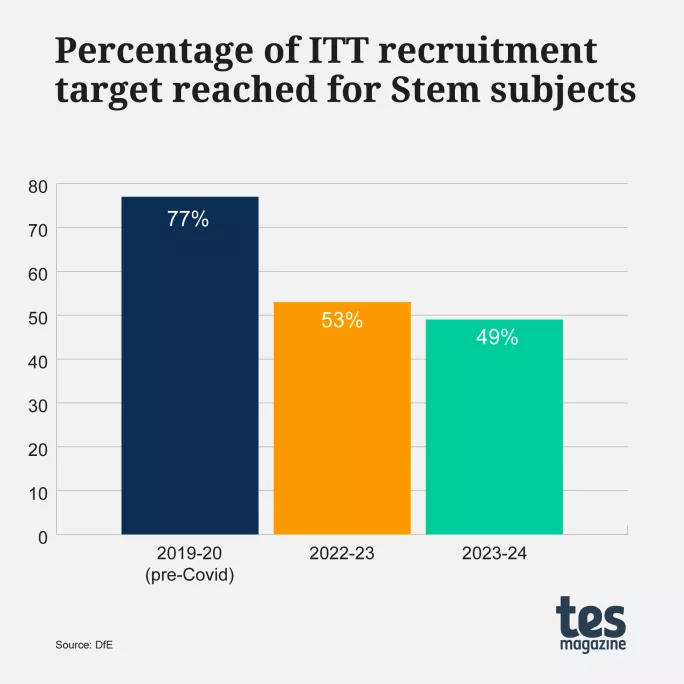
In 2019-20, the number of ITT entrants to Stem subjects made up 77 per cent of the DfE target.
The latest figures come despite the 2022 introduction of the Stem levelling up premium payment for early career teachers teaching maths, physics, chemistry and computing in around 4,500 eligible state-funded secondary schools across England.
The English Baccalaureate (EBacc) suite of subjects, meanwhile, is made up of English language and literature, double science, maths, a humanities subject and a modern foreign language.
It was created as a performance measure in 2011 by the government to encourage schools to ensure more students study traditional academic subjects.
However, today’s data reveals that most of the EBacc subjects failed to reach their recruitment targets this year.
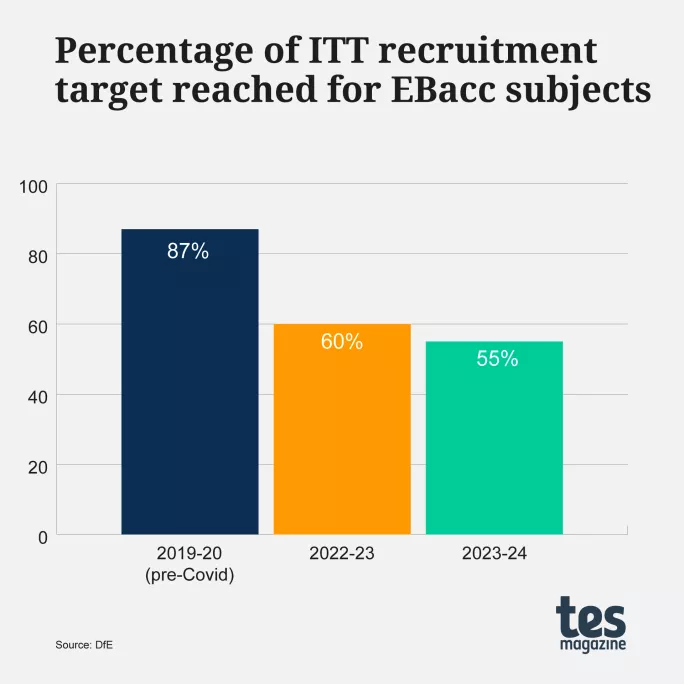
Overall, the DfE missed its recruitment target for EBacc subjects by 45 per cent, up from 40 per cent last year.
Teacher recruitment crisis has ‘plumbed new depths’
Geoff Barton, general secretary of the Association of School and College Leaders, said: “This catastrophic shortfall in postgraduate trainee teacher recruitment has plumbed new depths.”
“It is even worse than last year - which was itself a new low point - and follows years of missed targets.”
He urged the government “to see sense and take action”.
“There is simply no issue in education that is more important than fixing the broken teacher pipeline.”
Jack Worth, school workforce lead at the National Foundation for Educational Research (NFER), said “dire data confirms that teacher supply is a critical issue”.
“The shortfalls being so universal - 15 out of 18 secondary subjects missing their targets and not just in the usual shortage subjects - should be of enormous concern to policymakers.”
Mr Worth said that the government needs to take “urgent and radical action to improve the attractiveness of teaching as a profession to enter and remain in by enhancing bursaries and other financial incentives, reducing workload and improving the competitiveness of teachers’ pay”.
The worst shortfall subjects
The subject with the worst shortfall in trainees recruited was business studies, with just 16 per cent of the number forecast to be needed starting courses this year.
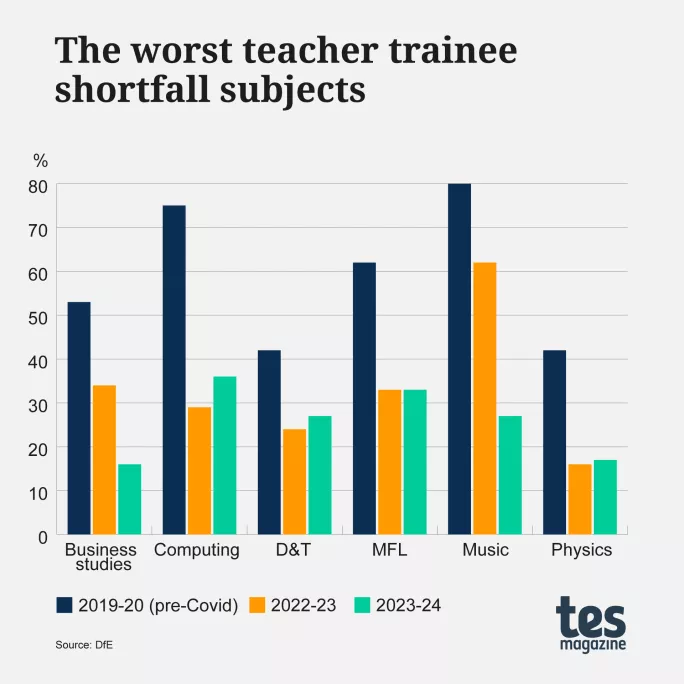
Physics once again saw less than one-fifth of the target number of trainees recruited on to courses this year (17 per cent), while design and technology courses managed to attract just over a quarter of the required trainees (27 per cent), with music also attracting just 27 per cent of recruits needed.
Meanwhile, just a third of the modern foreign languages trainees needed were recruited - a major slump from before the pandemic, when almost double the proportion of the target was recruited (62 per cent).
The DfE also failed to recruit two-thirds of the number of computing teachers it said was needed this year.
Maths teacher shortage
In maths, the target for the number of trainee teachers needed was missed by 37 per cent, a wider margin than last year’s 12 per cent shortfall.

It comes in the same year that the prime minister announced his maths-to-18 ambition.
A member of the expert advisory group on maths to 18 said earlier this year that providing non-maths teachers with CPD to teach the subject could be necessary to deliver on the plans.
Primary trainee numbers rebound
In primary, while recruitment fell by 17 per cent year-on-year from 10,640 in 2022-23 to 8,844 this year, a larger proportion of the target was achieved (96 per cent) after the DfE lowered its target.
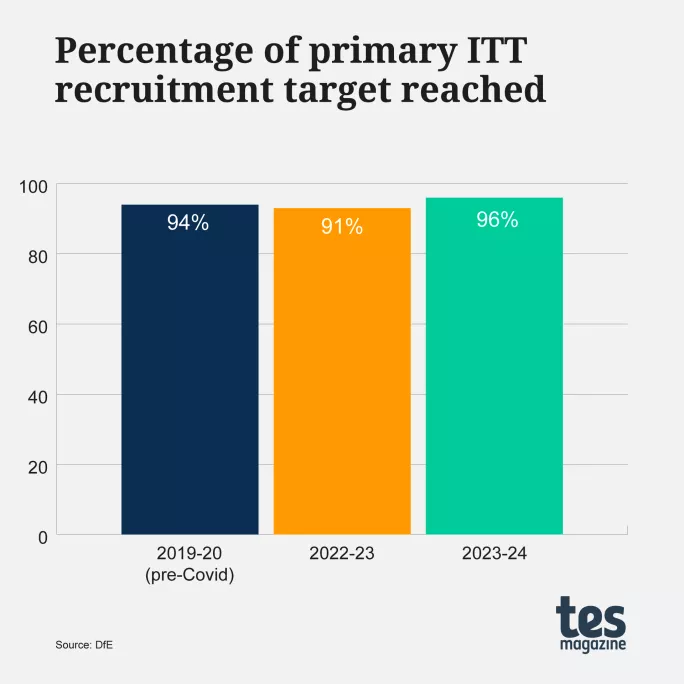
Last year, primary recruitment, as a percentage of the target, fell to 91 per cent, its lowest level since 2014-15.
Since then, the primary trainee recruitment target has been met or exceeded five times, most recently in 2021-22.
Trainee numbers slump across England
Overall, across primary and secondary, recruitment to postgraduate initial teacher training courses fell across all regions.
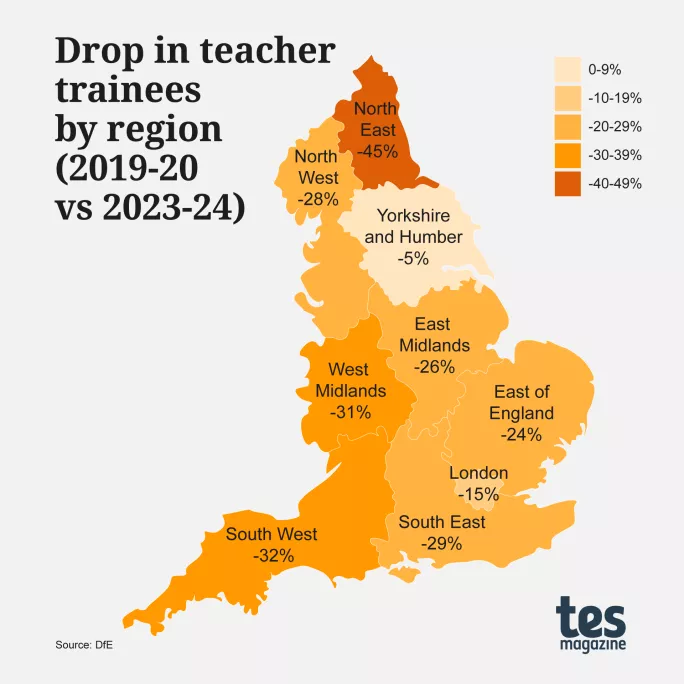
In the North East, recruitment has fallen by 45 per cent since 2019-20, the last pre-Covid year.
The region also recruited the smallest number of trainees, with just 823 new entrants this year, down from 916 last year.
Elsewhere, the South West and the West Midlands experienced steep drops in trainees recruited, with levels down by almost a third this year compared with 2019-20.
Age group discrepancies
Overall, recruitment across primary and secondary fell year-on-year from 22,673 to 21,946.
However, recruitment across age groups varied. While the number of trainees aged 39 and under fell by 7 per cent, the number of trainees aged 40 and over rose by 14 per cent.
Graihagh Crawshaw-Sadler, chief executive of Now Teach, said that the data shows a “cultural shift in the world of work and in teaching specifically”.
“There is a huge increase in the number of people in the middle or later stage of their career deciding to do something meaningful and retrain to become teachers,” she added.
Targets met - but in only three subjects
Just three subjects managed to exceed their targets this year.
For history, 119 per cent of the DfE’s trainee recruitment target was reached, slightly below last year’s figure of 129 per cent.

Classics also exceeded its target with almost double the target number of trainees being recruited, while there was a similar picture in PE, for which 181 per cent of the ITT recruitment target was achieved.
A DfE spokesperson said that the department was taking “long-term decisions to build up incentives, cut workload and increase the routes into the teaching profession”.
“This year we have seen initial teacher training recruitment improve in key subjects like biology, physics and computing.
“We are boosting our recruitment incentives with special bonuses of up to £30,000 after tax over the first five years of their career for those who teach key subjects.”
You need a Tes subscription to read this article
Subscribe now to read this article and get other subscriber-only content:
- Unlimited access to all Tes magazine content
- Exclusive subscriber-only stories
- Award-winning email newsletters
Already a subscriber? Log in
You need a subscription to read this article
Subscribe now to read this article and get other subscriber-only content, including:
- Unlimited access to all Tes magazine content
- Exclusive subscriber-only stories
- Award-winning email newsletters



